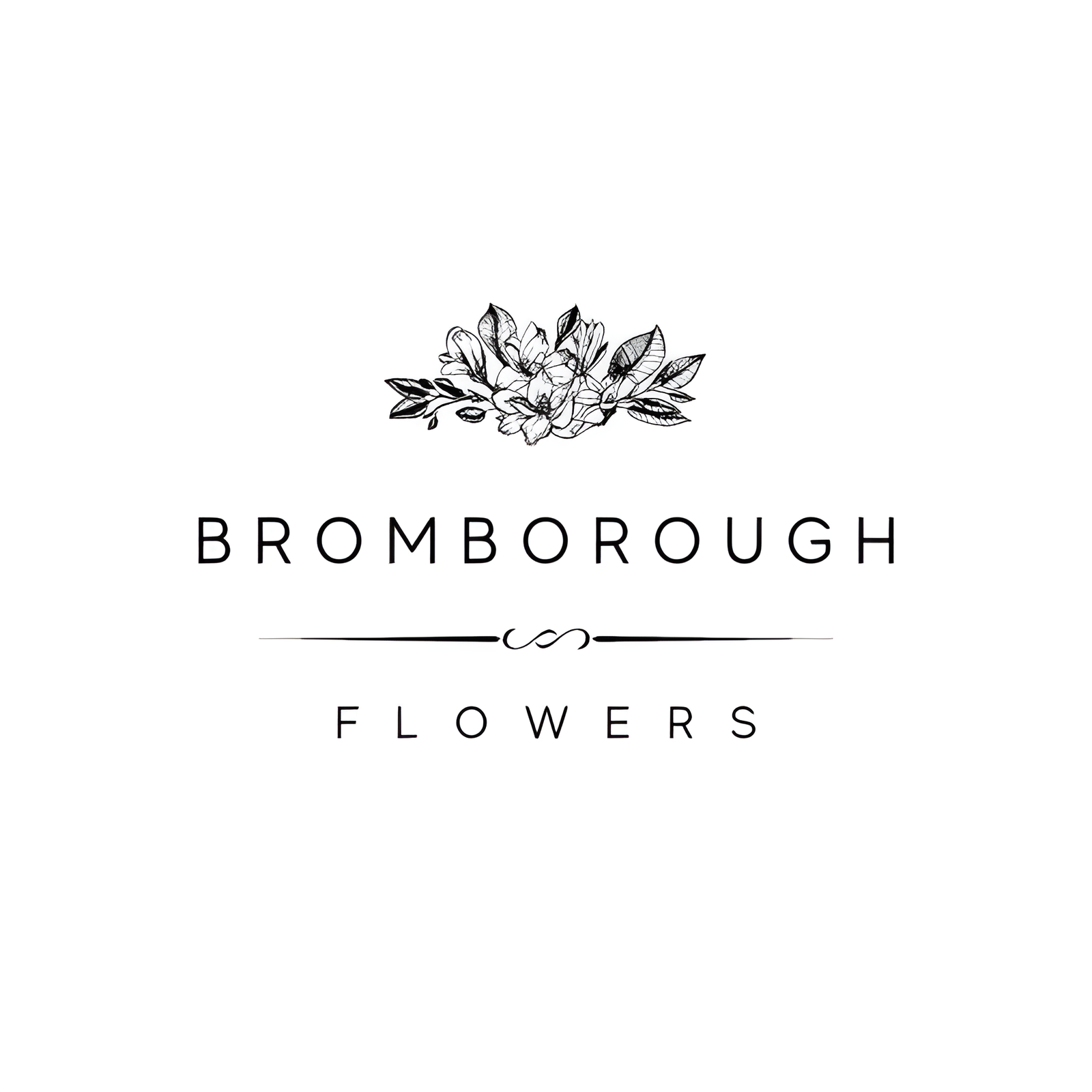When planning a wedding, the choice of flowers plays a pivotal role in setting the tone and ambiance of the celebration. Gypsophila, more commonly known as Baby’s Breath, offers a timeless elegance with its delicate, airy blooms that are both budget-friendly and versatile. Whether used as a primary focus or a complementary filler, this flower’s small, clustered blooms are available in various colors, adding a romantic touch to any arrangement. But what makes Baby’s Breath so enduring in wedding traditions, and how can you best incorporate it into your special day? The answers lie in its rich history and multifaceted uses.
Flower Overview
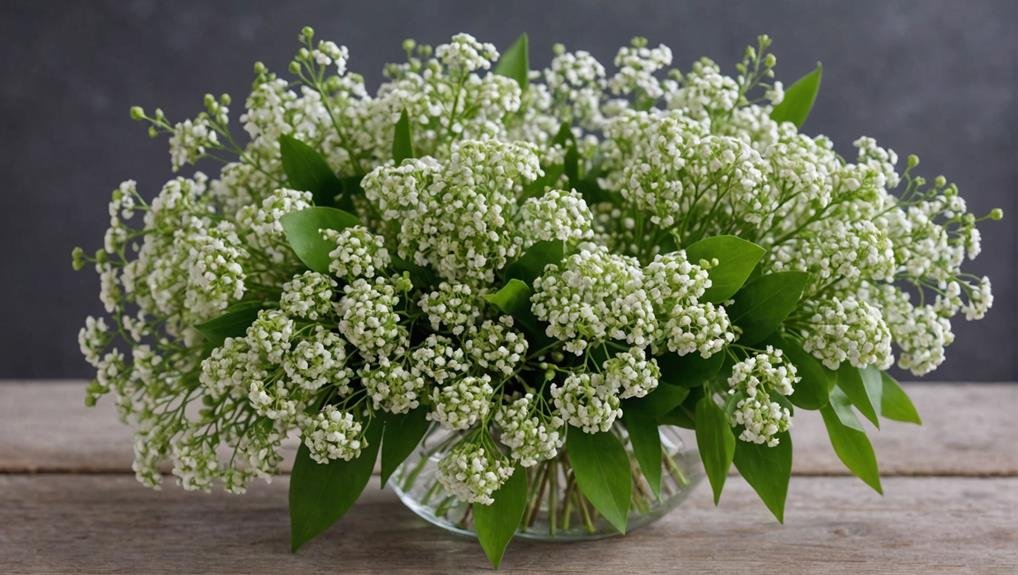
Baby’s Breath, or Gypsophila, is renowned for its delicate, airy blooms and has become a favored choice for wedding arrangements due to its symbolic meanings and versatility. This flower is often chosen for its representation of everlasting love, purity, and innocence, making it a meaningful addition to any wedding bouquet.
Its versatility allows it to serve as both a primary focus and a complementary filler flower in various arrangements, enhancing the overall aesthetic with its understated elegance.
The Baby’s Breath flower is the perfect choice for couples looking to add a touch of charm and sophistication to their wedding decor. Its delicate clusters of small blooms are often used to fill gaps in bouquets, garlands, and centerpieces, creating a fuller and more cohesive look.
As a budget-friendly option, Baby’s Breath flowers allow for beautiful, cost-effective DIY projects, making them ideal for brides and grooms who wish to stay within a modest budget while maintaining a high level of elegance in their floral arrangements.
With its ability to be dyed in various colors or used in its classic white form, Gypsophila offers flexibility in matching any wedding theme or color palette, further solidifying its status as a wedding favorite.
Physical Description
Gypsophila, commonly known as Baby’s Breath, features small, delicate blooms that are typically clustered in airy, cloud-like formations. These charming flowers are renowned for their light, sweet scent and their ability to add a soft, romantic touch to any floral arrangement. Baby’s Breath flowers are notably small, with each bloom measuring approximately 1/2 inch in diameter.
The blooms, known as gypsophila, are predominantly white flowers, though they can also be found in tinted variations. These flowers are clustered on stems that vary significantly in length, ranging from 6 inches to 2 feet. This variability in stem length allows for versatile use in floral arrangements, from compact bouquets to expansive, cascading designs.
The physical description of Baby’s Breath includes its fine, branching stems that support a multitude of tiny blooms, creating a voluminous and cloud-like effect. This characteristic makes them ideal for filling out bouquets and adding texture to floral displays. Additionally, the flowers’ light, airy appearance complements a wide range of other flowers, enhancing the overall aesthetic without overpowering it.
When properly cared for, Baby’s Breath can maintain its beauty for 5 to 10 days, making it a practical choice for wedding arrangements.
Available Colour Varieties
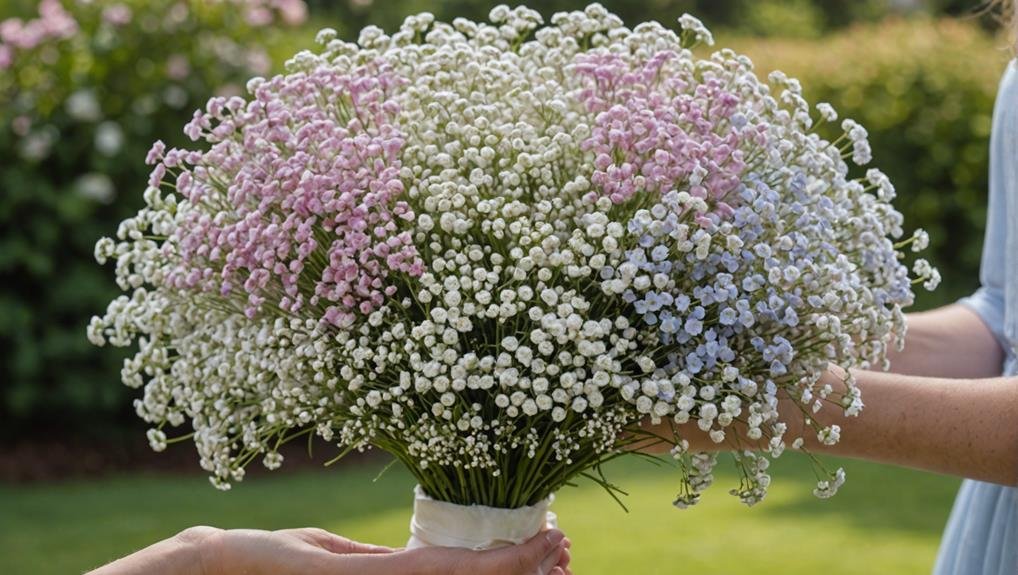
White, pink, and tinted variations of Gypsophila offer a wide array of options for enhancing floral arrangements with different color palettes. White Baby’s Breath is the quintessential choice for weddings, symbolizing purity and innocence. Its delicate, cloud-like appearance makes it an ideal addition to traditional ceremonies, effortlessly complementing classic bridal bouquets and elegant centerpieces.
Pink Baby’s Breath introduces a soft, romantic touch to floral arrangements, making it perfect for whimsical or vintage-themed weddings. The subtle hue of pink flowers can create a dreamy, enchanting atmosphere, adding a gentle pop of color without overwhelming the overall aesthetic.
For those looking to personalize their wedding color palette further, tinted Baby’s Breath provides an assortment of unique shades. These tinted variations allow for creative and tailored floral designs, guaranteeing that the flowers match any specific color scheme or theme. By incorporating tinted Baby’s Breath, couples can achieve a cohesive and visually striking look, enhancing the overall ambiance of their special day.
The diverse color variety of Gypsophila assures that it can smoothly integrate into any wedding setting, offering versatile options to suit a broad range of design preferences and enhancing the beauty of floral arrangements.
Latin Name and Taxonomy
The botanical classification of Baby’s Breath reveals its roots in the Caryophyllaceae family, with the genus Gypsophila encompassing over 100 species of flowering plants.
The Latin name for Baby’s Breath is Gypsophila, which is derived from the Greek words ‘gypsos’ meaning chalk, and ‘philos’ meaning loving, reflecting the plant’s preference for chalky soils.
Taxonomically, Baby’s Breath is situated within the Plantae kingdom, specifically classified under the division Magnoliophyta, the class Magnoliopsida, and the order Caryophyllales. This detailed classification aids botanists and horticulturists in identifying and understanding its botanical relationships and characteristics.
Understanding the Latin name and taxonomy of Gypsophila is essential for several reasons:
- Proper Identification: Accurate identification helps in distinguishing Baby’s Breath from other similar species within the Caryophyllaceae family.
- Cultivation Knowledge: Knowing its taxonomic position aids growers in providing optimal growing conditions and care.
- Floral Arrangements: Florists can guarantee the correct species is used, enhancing the quality and consistency of wedding floral designs.
Geographical Origins
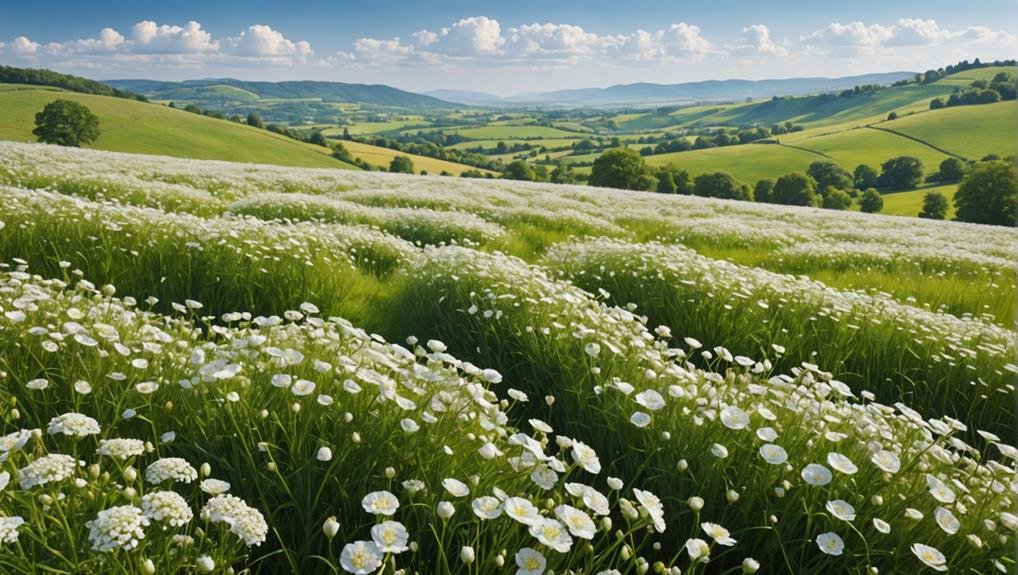
Building on the botanical classification, understanding the geographical origins of Gypsophila provides further insight into its growth preferences and historical uses. Gypsophila, commonly known as Baby’s Breath, originated from regions in Europe, Asia, and North Africa. This diverse geographical distribution has contributed to the flower’s adaptability and its ability to thrive in various climates.
Historically, these regions have utilized Baby’s Breath for its delicate and airy appearance, making it a longstanding favorite as a filler flower in floral arrangements. The flower’s origins in Europe, Asia, and North Africa have influenced its cultivation requirements. For best growth, Baby’s Breath necessitates well-drained soil, full sun exposure, and moderate moisture. These conditions are reflective of the native habitats where this species originally flourished.
Its enduring popularity in these regions has extended globally, with Baby’s Breath becoming a staple in wedding bouquets and various other decorative uses. The shift of Baby’s Breath from a simple filler flower to a prominent feature in wedding bouquets highlights its symbolic representation of everlasting love and purity. This historical and geographical context enriches our appreciation of Gypsophila and its place in modern floral design.
Season Availability
Gypsophila, commonly known as Baby’s Breath, is available throughout the year, providing a flexible option for floral arrangements in any season. This year-round availability makes it a popular choice for wedding flowers and other events, guaranteeing that it can be sourced regardless of the time of year.
However, there are variations in its peak availability, with fresh Baby’s Breath being most abundant during the spring and summer months. During these peak seasons, florists and event planners can expect to find a greater selection and potentially better quality flowers.
Dried Baby’s Breath, on the other hand, offers a long-lasting alternative that can be used at any time of the year, maintaining its appearance for extended periods without the need for water or special care.
Despite its year-round availability, it is important to note that seasonal variations can affect the availability of certain types or colors of Baby’s Breath. Planning ahead and discussing options with suppliers can help guarantee the desired floral arrangements.
- Baby’s Breath is available year-round.
- Fresh Baby’s Breath peaks in spring and summer.
- Dried Baby’s Breath is a long-lasting option.
Growing Conditions
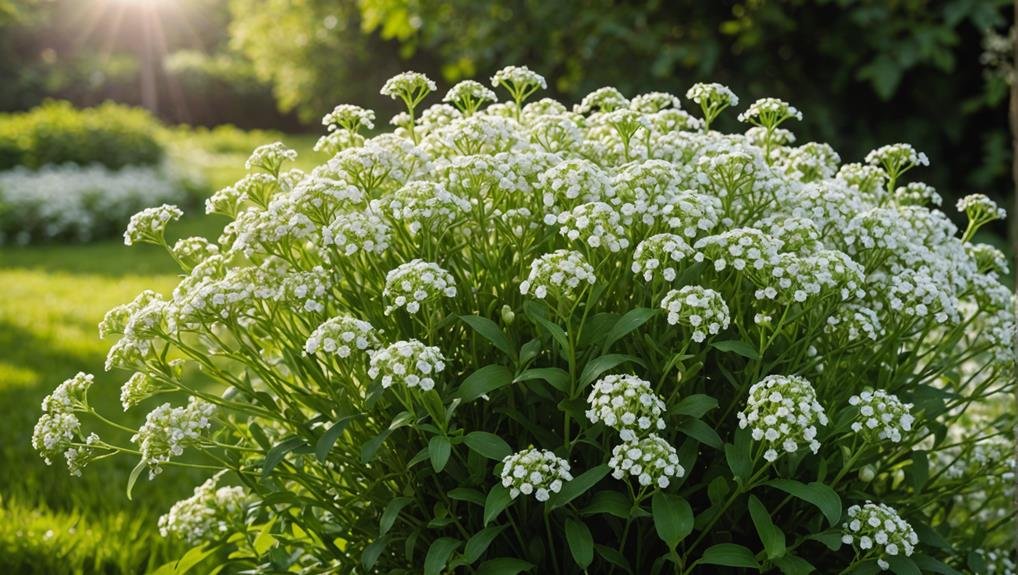
Thriving in well-drained soil and full sun exposure, Baby’s Breath flourishes best under conditions that offer moderate moisture and alkaline to neutral pH levels. To successfully grow Baby’s Breath, it is essential to guarantee that the soil is well-drained, preventing waterlogging which can be damaging to the plant’s roots. The ideal soil pH should range between 7.0 and 7.5, creating an environment conducive to healthy growth.
Baby’s Breath prefers full sun, requiring at least six hours of direct sunlight daily. This exposure is crucial for the plant’s robust growth and abundant flowering. When sowing Baby’s Breath seeds, you have the option to plant them directly in the ground or start them indoors in seed trays. For those in USDA zones 3 to 9, this plant can reach a height and width of up to 1.2 meters.
To care for Baby’s Breath effectively, it is important to keep the soil moist but not overly wet. Overwatering can lead to root rot, so moderate watering is vital. By providing these ideal growing conditions, you can ensure that Baby’s Breath will thrive, adding a delicate, airy beauty to any wedding arrangement.
Cultural Significance
Beyond its specific growing conditions, Baby’s Breath holds significant cultural importance, particularly in the context of weddings. Known for its delicate and ethereal appearance, Baby’s Breath symbolizes everlasting love and innocence. This symbolism has made it a cherished choice in wedding ceremonies, where it is often used to signify purity and young love.
The cultural significance of Baby’s Breath extends beyond its visual appeal. It represents the beauty of new beginnings and pure emotions, aligning perfectly with the sentiments of a wedding. This delicate flower is not just a filler in floral arrangements but a carrier of profound meaning and tradition.
The following points encapsulate the cultural significance of Baby’s Breath in weddings:
- Everlasting Love: Baby’s Breath symbolizes enduring affection and commitment, making it an ideal flower for wedding celebrations.
- Innocence and Purity: Its delicate white blooms are often associated with purity and innocence, attributes highly valued in matrimonial contexts.
- Timeless Symbolism: The flower’s enduring cultural significance assures its continued popularity and relevance in wedding traditions.
Typical Use in Weddings
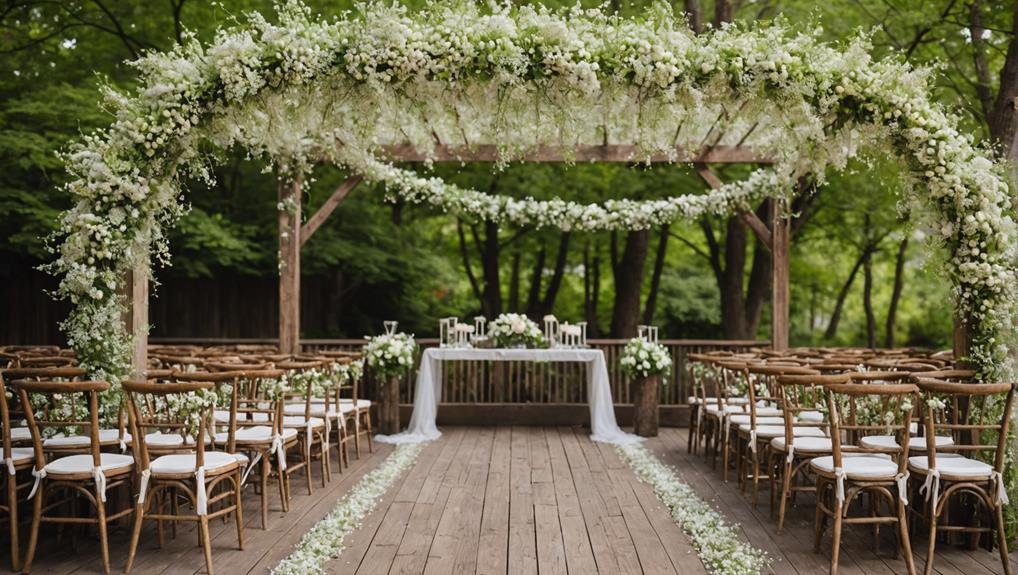
Often incorporated into various wedding elements, Baby’s Breath serves as a versatile and elegant choice for adding volume and texture to floral arrangements. This delicate flower is often used as a filler in bridal bouquets, enhancing the primary blooms with its soft, cloud-like clusters. Its ability to symbolize everlasting love and innocence makes it a popular option for wedding decor, resonating well with the romantic nature of the occasion.
In addition to bouquets, Baby’s Breath is frequently utilized in boutonnieres, centerpieces, and garlands, contributing to a cohesive and elegant aesthetic throughout the wedding. Its versatility and budget-friendly nature make it particularly appealing for couples planning DIY weddings. Whether used to create ethereal centerpieces or charming garlands, this flower’s simple beauty adds a touch of romance without overwhelming the overall design.
Beyond traditional arrangements, Baby’s Breath can be creatively employed in unique installations such as chandeliers and wreaths, providing an enchanting atmosphere at both ceremonies and receptions. Its popularity stems from its ability to blend seamlessly with a variety of wedding themes and color palettes, making it a timeless choice for couples seeking an elegant yet cost-effective floral solution.
Alternative Flower Types
Frequently chosen as alternatives to Baby’s Breath, flowers like gerbera daisies offer vibrant colors and a cheerful symbolism that can enhance a wedding’s floral decor. Known for their radiant hues and versatility, gerbera daisies symbolize innocence, cheerfulness, and purity, making them a fitting choice for wedding arrangements. These flowers thrive in warm climates with well-draining soil and require at least six hours of direct sunlight daily, ensuring their blooms remain vibrant throughout the event.
Gerbera daisies are particularly popular due to their ease of cultivation, as they can be grown from seeds, seedlings, or cuttings. This makes them an accessible option for those looking to incorporate DIY elements into their wedding planning. Additionally, their aesthetic appeal extends beyond traditional decorations, finding a place in flower crowns and greeting cards, adding a personal touch to wedding festivities.
For a visual representation of ideas, consider the following:
- Vibrant Colors: Gerbera daisies come in a variety of shades, from bright reds to soft pastels, catering to diverse wedding themes.
- Symbolism: Representing innocence and cheerfulness, they align well with the celebratory nature of weddings.
- Versatility: Suitable for garden borders, mixed beds, or potted arrangements, offering flexible decor options.
